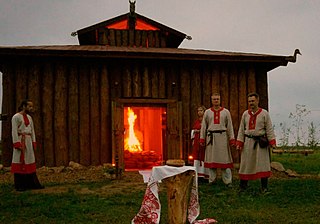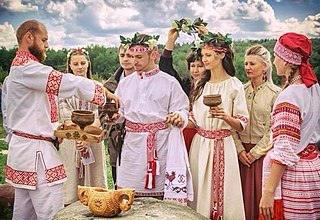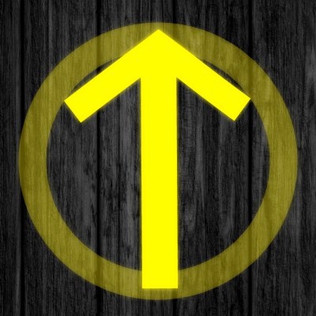Prav (Правь), Yav (Явь) and Nav (Навь) are the three dimensions or qualities of the cosmos as described in the first chapter of the Book of Light and in the Book of Veles of Slavic Native Faith (Rodnovery). Older sources mention only Nav and Yav concepts of ancient slavic cosmology, similar to Yin and Yang in Taoism, and Prav was not part of the concept. The literal meanings of the Prav, Yav, and Nav words, are, respectively, "Right", "actuality" and "probability". They are also symbolised as a unity by the god Triglav. Already Ebbo documented that the Triglav was seen as embodying the connection and mediation between Heaven, Earth and the underworld / humanity; these three dimensions were also respectively associated to the colours white, green and black as documented by Karel Jaromír Erben.

In the pre-Christian religion of Eastern and Southern Slavs, Rod is the god of the family, ancestors and fate, perhaps as the supreme god. Among Southern Slavs, he is also known as Sud. He is usually mentioned together with Rozhanitsy deities. One's first haircut (postriziny) was dedicated to him, in a celebration in which he and the rozhanitsy were given a meal and the cut hair. His cult lost its importance through time, and in the ninth or tenth century he was replaced by Perun, Svarog and/or Svetevid, which explains his absence in the pantheon of Vladimir the Great.

Dziady is a term in Slavic folklore for the spirits of the ancestors and a collection of pre-Christian rites, rituals and customs that were dedicated to them. The essence of these rituals was the "communion of the living with the dead", namely, the establishment of relationships with the souls of the ancestors, periodically returning to their headquarters from the times of their lives. The aim of the ritual activities was to win the favor of the deceased, who were considered to be caretakers in the sphere of fertility. The name "dziady" was used in particular dialects mainly in Poland, Belarus, Polesia, Russia, and Ukraine, but under different other names there were very similar ritual practices, common among Slavs and Balts, and also in many European and even non-European cultures.

George's Day in Spring, or Saint George's Day, is a Slavic religious holiday, the feast of Saint George celebrated on 23 April by the Julian calendar. In Croatia and Slovenia, the Roman Catholic version of Saint George's Day, Jurjevo is celebrated on 23 April by the Gregorian calendar.

The Slavic Native Faith, commonly known as Rodnovery and sometimes as Slavic Neopaganism, is a modern Pagan religion. Classified as a new religious movement, its practitioners hearken back to the historical belief systems of the Slavic peoples of Central and Eastern Europe, though the movement is inclusive of external influences and hosts a variety of currents. "Rodnovery" is a widely accepted self-descriptor within the community, although there are Rodnover organisations which further characterise the religion as Vedism, Orthodoxy, and Old Belief.

A volkhv or volhv is a priest in ancient Slavic religions and contemporary Slavic Native Faith.

Volhv Veleslav, also known as Влх. Велеслав and V.L.S.L.V., is a Russian Rodnover priest. He is also an author, artist, poet, teacher and lecturer. Veleslav is the founder of Rodolubie (Rodoljub) and the Veles circle. His early works form the basis of the Slavic neopaganism movement and its reconstruction. Veleslav is the author of several books on Russian and Slavic traditions, including The Doctrine/Teachings of the Magi: The White Book ; The Black Book of Mara (2008); Living Vedas of Russ: Revelations of Native Gods (2008); the Book of Veles's Tales (2005), and "The Book of the Great Nav" (2011), amongst many others. He has also contributed to the first magazine for Rodnovers, "Родноверие".

Ynglism, institutionally the Ancient Russian Ynglist Church of the Orthodox Old Believers–Ynglings, is a direction of Rodnovery formally established in 1992 by Aleksandr Yuryevich Khinevich in Omsk, Russia, and legally recognised by the Russian state in 1998, although the movement was already in existence in unorganised forms since the 1980s. The adherents of Ynglism call themselves "Orthodox", "Old Believers", "Ynglings" or "Ynglists".

Peterburgian Vedism or Peterburgian Rodnovery, or more broadly Russian Vedism and Slavic Vedism, is one of the earliest branches of Rodnovery and one of the most important schools of thought within it, founded by Viktor Nikolayevich Bezverkhy in Saint Petersburg, Russia, in the 1970s. Early Peterburgian Vedism developed independently from other Rodnover movements in the inland of Russia, due to the distinguished culture of the city of Saint Petersburg itself, and represents one of the most cohesive right-wing nationalist Rodnover movements.
In Slavic Native Faith (Rodnovery) there are a number of shared holidays throughout the year, when important ritual activities are set according to shared calendars. Generally speaking, ritual activities may be distinguished into "external" (exoteric) and "internal" (esoteric) relatively to the different communities. External ceremonies are mass gatherings, usually held on important holidays dedicated to the worship of common gods, and involving large numbers of people. Internal ceremonies are those restricted to specific groups, and holding special meaning for such groups; they may comprise private rituals and worship of specific ancestors.

Slavic Native Faith or Slavic Neopaganism in Russia is widespread, according to some estimates from research organisations which put the number of Russian Rodnovers in the millions. The Rodnover population generally has a high education and many of its exponents are intellectuals, many of whom are politically engaged both in the right and the left wings of the political spectrum. Particular movements that have arisen within Russian Rodnovery include various doctrinal frameworks such as Anastasianism, Authentism, Bazhovism, Ivanovism, Kandybaism, Levashovism, Peterburgian Vedism, Slavic-Hill Rodnovery, Vseyasvetnaya Gramota, the Way of Great Perfection, the Way of Troyan, and Ynglism, as well as various attempts to construct specific ethnic Rodnoveries, such as Krivich Rodnovery, Meryan Rodnovery, Viatich Rodnovery. Rodnovery in Russia is also influenced by, and in turn influences, movements that have their roots in Russian cosmism and identify themselves as belonging to the same Vedic culture, such as Roerichism and Blagovery.

Slavic Native Faith and Christianity are mutually critical and often directly hostile to each other. Among the Slavic Native Faith critiques are a view of religious monotheism as the root of mono-ideologies, by which is meant all ideologies that promote "universal and one-dimensional truths", unable to grasp the complexity of reality and therefore doomed to failure one after the other. These mono-ideologies include Abrahamic religions in general, and all the systems of thought and practice that these religions spawned throughout history, including both Marxism and capitalism, the general Western rationalistic mode of thinking begotten by the Age of Enlightenment, and ultimately the technocratic civilisation based on the idea of possession, exploitation and consumption of the environment. They are regarded as having led the world and humanity to a dead-end, and as destined to disappear and to be supplanted by the values represented by Rodnovery itself. To the "unipolar" world created by the mono-ideologies, and led by the American-influenced West, the Rodnovers oppose their political philosophy of "nativism" and "multipolarism".
Slavic Native Faith (Rodnovery) has a theology that is generally monistic, consisting in the vision of a transcendental, supreme God which begets the universe and lives immanentised as the universe itself, present in decentralised and autonomous way in all its phenomena, generated by a multiplicity of deities which are independent hypostases, facets, particles or energies of the consciousness and will of the supreme God itself.

In the Russian intellectual milieu, Slavic Native Faith (Rodnovery) presents itself as a carrier of the political philosophy of nativism/nationalism/populism (narodnichestvo), intrinsically related to the identity of the Slavs and the broader group of populations with Indo-European speaking origins, and intertwined with historiosophical ideas about the past and the future of these populations and their role in eschatology.

Festival of Perun, Perun's Day, Perunica is a Slavic festival in honor of the god Perun celebrated by modern Slavic neopagans (rodnovers); its existence in times before the Slavs began to be Christianized remains hypothetical.
Slavic-Hill Rodnovery is one of the earliest branches of Rodnovery that emerged in Russia in the 1980s founded by Aleksandr Konstantinovich Belov (1957–), and one of the largest Rodnover movements in terms of number of practitioners, counted in the many tens of thousands. The movement is characterised by a military orientation, combining Rodnover worldview with the practice of a martial arts style known as "Slavic-hill wrestling". The locution "Slavic hill" refers to the kurgan, Indo-European warrior mound burials of the Pontic–Caspian steppe.

The "Circle of Pagan Tradition" ("CPG") is one of the Russian Slavic Native Faith associations.

The Circle of Veles is an association of communities passionate about the development of Slavic native spirituality. Their patron is the god Veles, the Slavic god of wisdom. The supreme god is considered to be Rod, thus it is a Rodnovery (neo-pagan) association, common to Russia, Ukraine and Belarus.

Mono-ideologies are a concept in Russian political and philosophical discourse.















